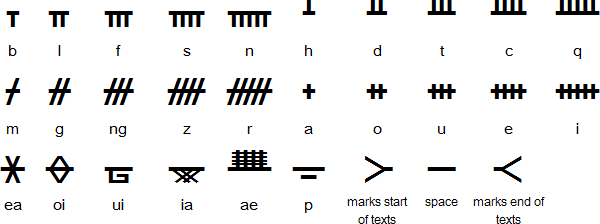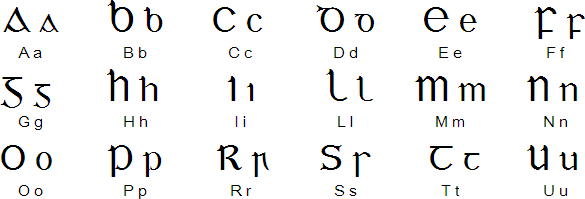Irish (Gaeilge)
Irish is a Celtic language spoken in mainly Ireland (Éire).
There are also Irish speakers in the UK (Ríocht
Aontaithe), the USA (Stáit Aontaithe Mheiriceá),
Canada (Ceanada) and Australia (an Astráil).
According to the 1996 census, 1.43 million people in Ireland claim to
have some knowledge of Irish, 353,000 of whom speak it regularly. The main
concentrations of Irish speakers are in the Gaeltachtaí,
which are scattered mainly along the west coast of Ireland and have
a total population of 82,715, 76.3% of whom speak Irish.
Names of the language
Irish is known as Irish, Gaelic or Irish Gaelic in English. The official
standard name in Irish is Gaeilge /’geɪlɪk/. Before the
1948 spelling reform, this was spelled Gaedhilge. In Middle Irish the
name was spelled Gaoidhealg, and it was Goídelc in Old Irish.
Other regional variations of the name in modern Irish dialects include
Gaedhilic, Gaeilic, Gaeilig or Gaedhlag
in Ulster and northern Connacht, and Gaedhealaing, Gaoluinn
or Gaelainn in Munster.
Relationship to other languages
Irish is a member of the Goidelic branch of Celtic languages, also known as
Q-Celtic. It is closely related to Manx (Gaelg/Gailck)
and Scottish Gaelic (Gàidhlig), the
other Goidelic languages. There is some degree of mutual intelligibility between
them, particular between the Scottish Gaelic of Islay and Argyll, Ulster Irish,
and Manx. The grammar and vocabulary of these languages are quite similar, but
the spelling and pronunciation are different, especially Manx spelling.
Irish is distantly related to Welsh (Cymraeg),
Cornish (Kernewek) and Breton
(Brezhoneg), which form the Brythonic branch of the Celtic languages,
also known as P-Celtic. The Celtic languages all have a similar grammatical structure,
but have relatively little vocabulary in common.
Here is an illustration of some of the differences and similarities between
the Celtic languages using the phrase ‘I live in Ireland’:
- Irish – Tá mé i mo chónaí i nÉirinn
- Scottish Gaelic – Tha mi a’ fuireach ann an Éirinn
- Manx – Ta mee cummal ayns Nerin
- Welsh – Dw i’n byw yn Iwerddon
- Cornish – Trigys ov yn Iwerdhon
- Breton – E Iwerzhon emaon o chom
Celtic connections – words that are similar in the Celtic languages
Dialects
There are three main dialects of Irish: Munster (An Mhumhain),
Connacht (Connachta) and Ulster (Ulaidh). The Munster
dialect is spoken mainly in Kerry (Ciarraí) and Muskerry
(Múscraí) in the western part of County Cork
(Contae Chorcaí). The Connacht dialect is spoken
mainly in Connemara (Conamara), the Aran Islands
(Oileáin Árann) and Tourmakeady (Tuar Mhic
Éadaigh) in County Mayo (Maigh Eo). The main area where the Ulster
dialect is spoken is the Rosses (na Rosa). The dialect of Gweedore
(Gaoth Dobhair) is essentially the same as the Ulster dialect.
The Official Standard (An Caighdeán Oifigiúil)
During the 1950s and 1960s a standardised form of Irish, known the
An Caighdeán Oifigiúil (The Official Standard) was developed.
It combines elements from the three major dialects and its pronunciation
is based on the Connacht dialect. This is the form of the language
taught in most schools.
Decline and revival
Between the 17th and early 20th centuries, the Irish language was gradually
replaced by English in most parts of Ireland. Famine and migration in
the 19th and 20th centuries led to its further decline. However when
the Republic of Ireland came into being in 1922, Irish was adopted as
an official language, along with English, and the government and civil
service become, in theory at least, officially bilingual. Irish terms
were also adopted for the titles of public figures and organisations
– Garda (Police), Taoiseach (Prime Minister), Dail (Parliament).
Recently the Irish language has experienced a revival with the
foundation of new publications, a radio service, a television
station and the growth of Irish-medium education. Irish is also
increasingly being used on independent radio stations in Ireland.
Origin of writing in Ireland
Irish first began to appear in writing in Ogham inscriptions between the 4th
and 6th centuries AD. When St Patrick introduced Christianity
to Ireland in the 5th century, Irish writers began to write in Latin,
and at the same time Irish literature written in the Latin alphabet
began to appear. The Viking invasions of the 9th and 10th centuries
led to the destruction of many early manuscripts, so most surviving
manuscripts were written after that time.
The Ogham alphabet (᚛ᚑᚌᚐᚋ᚜)
The Ogham alphabet was used to write Archaic Irish, Old Welsh and Latin
and Ogham inscriptions have been found in various parts of Ireland and
the British Isles.

Irish uncial alphabet/Gaelic Script

The Irish uncial alphabet originated in medieval manuscripts as a variant
of the Latin alphabet. It was used for printing Irish until quite recently
and is still used on road signs and public notices throughout Ireland.

More information about the Irish uncial alphabet
Modern Irish alphabet (an aibítir)
Today Irish is usually written with a version of the Latin alphabet
similar to the one used for Scottish Gaelic,
though a spelling reform in 1957 eliminated some of the silent letters
which are still used in Scottish Gaelic.
| A a | B b | C c | D d | E e | F f | G g | H h | I i |
|---|---|---|---|---|---|---|---|---|
| á | bé | cé | dé | é | eif | gé | héis | í |
| L l | M m | N n | O o | P p | R r | S s | T t | U u |
| eil | eim | ein | ó | pé | ear | eas | té | ú |
